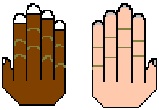Usually, three main parts (angas) of a tala are used in BASIC practice. These are called:
Anudhruta, Druta and Laghu. The conventional notation is shown in brackets.
Anudhruta (U) is ALWAYS one akshara kala* in duration. A beat of the palm is used for anudhruta.

Druta (0) is ALWAYS two akshara kala* in duration. A beat and a wave of the palm is used for Druta.
Laghu (1) may be of 3 or 4 or 5 or 7 or 9 akshara kala* in duration depending on the Jaati of the tala. A beat followed by finger count is used for Laghu. An example of Laghu with four akshara kala:
There are five Jaatis of tala:
The concept of 'matra kala' is used in Vedic chanting as well. A matra kala is a unit of duration.
Based on vedic chanting, matra kala is approximately of 300 milli-sec in duration.
Sapta Talas: The name of the tala is given based on the sequence of the three parts, the angas. The seven talas – Sapta talas are:
Some examples of computer notation of talas:
Thisra Jaati TripuTa: 1(3) 0 0
Adi: 1(4) 0 0.
Chatturashra Jaati Rupaka: 0 1(4).
Chaturashrajati-MaTya: 1(4) 0 1(4)
Mishrajati-Jhampe: 1(7) U 0
Speed: There are three speeds: first speed - Vilamba, second speed -Madhya and third speed - Dhruta.
The number of swaras in one askhara kala depends on the speed. If for first speed there is one swara per beat, then for second speed there are two swaras per askhara kala and and for the third speed there are four swaras per askhara kala. A long swara is counted as two askhara kalas.
As a rule, the number of aksharas in second speed is double the number of aksharas in the first speed. The number of aksharas in third speed is double the number of aksharas in the second speed.
Anudhruta (U) is ALWAYS one akshara kala* in duration. A beat of the palm is used for anudhruta.

Druta (0) is ALWAYS two akshara kala* in duration. A beat and a wave of the palm is used for Druta.

Laghu (1) may be of 3 or 4 or 5 or 7 or 9 akshara kala* in duration depending on the Jaati of the tala. A beat followed by finger count is used for Laghu. An example of Laghu with four akshara kala:

There are five Jaatis of tala:
- Thishra Jaati (3 aksharas)
- Chaturashra Jaati (4 aksharas)
- Khanda Jaati (5 aksharas)
- Misra Jaati (7 aksharas) and
- Sankeerna Jaati (9 aksharas)
The concept of 'matra kala' is used in Vedic chanting as well. A matra kala is a unit of duration.
Based on vedic chanting, matra kala is approximately of 300 milli-sec in duration.
Sapta Talas: The name of the tala is given based on the sequence of the three parts, the angas. The seven talas – Sapta talas are:
- Druva: 1 0 1 1
- MaTya: 1 0 1
- Rupaka: 0 1
- Jhampe: 1 U 0
- TripuTa: 1 0 0
- ATTa: 1 1 0 0
- Eka: 1
Some examples of computer notation of talas:
Thisra Jaati TripuTa: 1(3) 0 0
Adi: 1(4) 0 0.
Chatturashra Jaati Rupaka: 0 1(4).
Chaturashrajati-MaTya: 1(4) 0 1(4)
Mishrajati-Jhampe: 1(7) U 0
Speed: There are three speeds: first speed - Vilamba, second speed -Madhya and third speed - Dhruta.
The number of swaras in one askhara kala depends on the speed. If for first speed there is one swara per beat, then for second speed there are two swaras per askhara kala and and for the third speed there are four swaras per askhara kala. A long swara is counted as two askhara kalas.
As a rule, the number of aksharas in second speed is double the number of aksharas in the first speed. The number of aksharas in third speed is double the number of aksharas in the second speed.